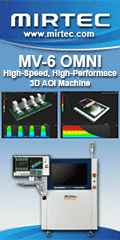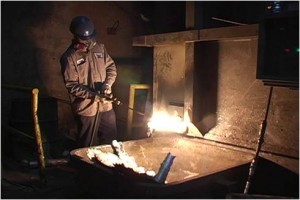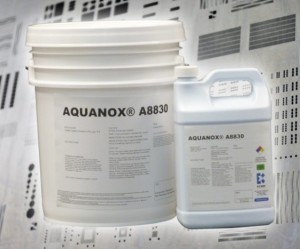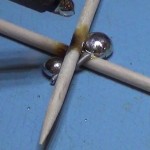Abstract
Managing solder wastes and byproducts properly has never been more important due to the increasing scope and complexity of The Resource Conservation and Recovery Act (RCRA), enacted in 1976 and amended many times since then. The regulation covering the transportation, storage, treatment, and disposal of hazardous wastes are contained in Subtitle C of RCRA. Subtitle C regulations establish a never-ending, “cradle to grave” liability for generators of hazardous wastes. It is incumbent upon generators to fully understand how materials should be classified, how they should be managed, and what records they must keep in order to ensure that they are in compliance with the law.
 The regulations governing maintenance consumables, spent solder paste containers, and other solder-contaminated trash materials that are not able to be reused (“Paste & Wipes”) are among them most confusing and misunderstood of all the regulations covering solder related materials. Paste and Wipes are solid wastes that, under 40 CFR, §262.11-c are usually identified as Characteristically Hazardous Wastes because they fail the TCLP test for lead, or because they have a flash point less than 135 ° Fahrenheit. The generator is always responsible for properly characterizing his waste, so unless you have data demonstrating that your Paste & Wipes are not hazardous, it is best to assume that they are.
The regulations governing maintenance consumables, spent solder paste containers, and other solder-contaminated trash materials that are not able to be reused (“Paste & Wipes”) are among them most confusing and misunderstood of all the regulations covering solder related materials. Paste and Wipes are solid wastes that, under 40 CFR, §262.11-c are usually identified as Characteristically Hazardous Wastes because they fail the TCLP test for lead, or because they have a flash point less than 135 ° Fahrenheit. The generator is always responsible for properly characterizing his waste, so unless you have data demonstrating that your Paste & Wipes are not hazardous, it is best to assume that they are.
Generators must also declare their generator status (large or small generator) based upon the volume of hazardous waste that they generate annually, according to their state’s RCRA program, and make a determination of classification for each waste stream generated, stored, or treated at their facility. This puts a large burden on the shoulders of environmental and plant managers, to understand the regulations regarding their wastes, since not all states have the same regulations. In general, generators should be familiar with not only their own state’s RCRA-equivalent programs, but the federal regulations. And the regulations in the state(s) where their wastes are treated, disposed, and/or recycled. In the following article we’ll expand on some of the regulations that apply specifically to solder and solder-related waste streams and the importance of understanding which Federal Regulations apply .
Introduction/Executive Summary
The Resource Conservation and Recovery Act was the first major amendment to the 1965 Solid Waste Disposal Act, which was drafted in response to the nation’s unprecedented growth of municipal solid waste and the need to safely manage it. It was revolutionary at the time as the previous solid waste rules did very little to encourage reuse, recycling, or stringently control hazardous waste streams. As part of RCRA, the states were given the option to administer the new programs, after submitting a plan to EPA, or to cede control of their programs to the federal government. The law required that any state program must be at least as stringent as the federal program, establishing a minimum threshold.
As of this writing, all but two states have had their plans approved and have been administering their own RCRA programs. This has led to some confusion due to differing state regulations, some of which are far more stringent than the Federal Regulations. An illustration of that is the fact that Rhode Island has only two hazardous waste generator status subsets with no exemptions whereas most other states offer exemptions to entities that produce small amounts of hazardous waste. This means that in some states you can ship small quantities of hazardous waste using any trucking company, and in other states, you must use a Licensed Hazardous Waste Transporter and a Hazardous Waste Manifest, irrespective of volume. In short, it is imperative that you understand what your obligations are when managing your waste streams, both in the state where the waste is generated and in any state where the waste is shipped. In 2008, the EPA revised the RCRA regulations with the intention of making it even more attractive to recycle certain types of materials rather than disposing of them. This revision is called the “2008 Definition of Solid Waste”, which was revised further in 2011. This rule was highly controversial as it created many exemptions to which environmentalists, including the Sierra Club, took exception and sued EPA in response. Of all of the states, only a few have adopted these rules (Pennsylvania, New jersey, and Illinois), and thus these three are the only states whose programs recognize the new definitions of solid waste that create exemptions for materials generated by the electronics assembly industry.
RCRA as it Applies to Solder, Dross, Solder-Contaminated Waste, and Chemicals
There are many waste streams that are generated by electronics assemblers, many of which are process-dependent, and each stream must be classified under the RCRA regulations and handled accordingly. In almost all cases, these materials are not hazardous wastes when they are recycled:
Solder Dross
Lead-bearing and lead-free solder dross from wave soldering is not considered a hazardous waste (or a waste at all if they are reclaimed, despite exhibiting a hazardous characteristic, because they are considered byproducts under 40 CFR 261.2(c)(3). Byproducts that exhibit a hazardous characteristic are not solid (or hazardous) wastes if they are reclaimed.What this means to an electronics assembler is that you may ship solder dross to a recycling facility without using a hazardous waste manifest or hazardous waste transporter.
Solder Paste
Containers of lead-bearing and lead-free solder paste products, whether off-spec, or partially empty are also exempt from being considered hazardous when reclaimed because they may be considered a Commercial Chemical Product, provided the constituent target materials are qualifying. Completely empty containers are exempt from being considered hazardous waste, and do not require recycling or hazardous waste treatment if they have less than 2.5mm (0.98”) of residue on the bottom of the container or 3% by weight remains in the container, per 40 CFR, 261.7(b).
Solder-Contaminated Wastes
Solder-contaminated wastes such as pre-saturated and/or dry wipes, contaminated swabs, gloves, rags, and other materials of the sort are considered spent materials under 40 CFR 261.1(c)(1). Spent materials that exhibit a hazardous characteristic are hazardous wastes, even if they are recycled. Unless the generating site is a Conditionally Exempt Small Quantity Generator, generators outside of the three states that have adopted the 2008 DSW rules must ship these materials to a recycler using a hazardous waste transporter and a hazardous waste manifest. The generator’s state has jurisdiction over the classification of any waste stream generated in the state, and it is therefore illegal to classify these waste streams as exempt under the 2008 DSW rules, unless the waste was generated in a state that has adopted these rules.
Common Compliance Problems
Since almost every state manages their own RCRA program, and the regulations in many states differ in important ways from the Federal RCRA regulations, it is easy to make a mistake when transporting wastes from one state to another. US EPA has taken the position that generators and transporters must obey the regulations of each state through which the waste passes during shipment. Thus, even if the state in which a waste, such as Paste & Wipes, is recycled does not regulate this material as a hazardous waste, if the state in which the material is generated regulates it as hazardous, or any state through which the transporter carries it regulates it as hazardous, it must be shipped using a Licensed Hazardous Waste Transporter and a Hazardous Waste Manifest. In the specific case of Contaminated Trash the only situations where these materials could potentially be legally shipped without a manifest would be 1) intrastate shipments within the states of Pennsylvania, New Jersey, or Illinois, shipments between New Jersey and Pennsylvania (since these states are contiguous), and shipments by Small Quantity Generators in or through states which exempt them. Even then, there have been no Federal conclusory rulings and recyclers that operate out of these states are using their own interpretations of the law in order to conclude that their handling of these wastes are legal.
Many generators do not understand the requirements for interstate shipment of these materials, and are therefore potentially putting themselves in jeopardy for violations and fines if their records are inspected by a state or federal RCRA inspector familiar with these materials. If you are in doubt, you should contact your attorney or state RCRA office to obtain accurate information.
Sham Recycling Concerns Pertaining To Solder-Contaminated Waste
Sham recycling is regulatory term that, as applied to solder recyclers, requires recyclers to recycle only those materials that have significant concentrations of recoverable materials, defined as two to four percent recoverable value per 73 FR 64702. Solder-contaminated wastes are generally very low in recoverable metals, and are only accepted by recyclers if they are known to contain the minimum threshold set by the regulations. These materials are generally not suitable to be burned as fuel, and therefore, generators are required to either send the materials to a recycler for metal recovery, or to a hazardous waste landfill or other treatment facility.
Because of the “Legitimate Recycling Standard” position paper drafted by EPA, recyclers have only two options available to them when dealing with this type of material; they must recover the contained metal, use them as an effective substitute for a commercial product, or as an ingredient or intermediate in an industrial process. Up until very recently, virtually all of this material was burned in a furnace, with the metal value being recovered. Simply put, recovering metal from these kinds of material is costly, inefficient, produces large quantities of greenhouse gasses, and if feed materials aren’t periodically monitored and sampled for metal content, it can also be illegal.
New Technology Solving Compliance and Environmental Problems
Because of the nature of pyrometallurgical processes, specifically relating to converting solder dross and metallic oxides into refined metal products, oxidized metal requires a reagent to react with the oxygen. In many cases, these reagents are carbon-rich petroleum products, such as coke, which react with the oxygen and convert the metal oxides into metal, producing carbon dioxide as a byproduct that is discharged into the air.
Paste & Wipes pose several problems as a recyclable material, in addition to identifying whether they contain enough metal for legitimate recycling. First, they have a significant environmental impact because they are burned in order to recover the contained metal, releasing most of their weight in the form of carbon dioxide. This is troubling because of the pressure it puts on recyclers regarding their air permits, as well as the inefficiency (because only a small fraction of the material is actually recycled). The more immediate issue with these materials is that they are physically light in weight, and the immense heat of a furnace can often produce hot embers in the furnace, which can damage emission control equipment such as a bag houses. Even with cutting edge ember suppression technology, this material poses a real threat to recyclers. The fact is that recycling solder-contaminated trash has until now been a costly, and inefficient process.
Last year, Conecsus developed a revolutionary process that solved these complex problems in an elegant and efficient way, with results that surpassed expectation from both a real and regulatory standpoint. In developing this new process, Conecsus was not only able to exponentially reduce the risk of bag house fires, we were able to fully re-use solder contaminated waste in a manner that positively impacted our carbon dioxide emissions, reduced our dependence on petroleum carbon sources, and allows receive Paste & Wipes as an exempt material, without using a hazardous waste transporter or manifest. In other words, Conecsus can receive Paste & Wipes inexactly the same way we receive solder dross, oxides, and other recyclables.
This patent-pending technology allows generators to send their solder-contaminated waste to Conecsus as a reagent replacement rather than as a hazardous waste, and as a result, it also reduces the amount of hazardous waste you generate. You would no longer have to report these materials as hazardous waste, which could result in your status to changing from a Large Quantity or Small Quantity generator to a Conditionally Exempt Small Quantity Generator, thereby allowing you to ship a much wider array of waste streams without the problems and liabilities of managing hazardous wastes.
Conclusion
In conclusion, using a recycler in a state that has adopted the 2008/2011 DSW rules does not reduce your overall reportable waste, and is very likely to be non-compliant with most states’ laws, where using a recycler with this technology is guaranteed to be legal in nearly all states, using their own statutes, will avoid using expensive hazardous waste carriers, and finally, will lower your overall reportable waste. The overall economic impact of this technology, for generators, is profound because generators can legally forego the use of hazardous waste transporters or manifests, and they can combine shipments of dross with Contaminated Trash. Not only does it reduce the generator’s carbon footprint through reuse of their waste, it also may allow generators that are on the lower end of a generator status level drop down to a lower level, lowering their overall waste costs across all of their waste streams.
Appendix 1: Where Are The 2008 DSW Rules In Effect?

Source: http://www.epa.gov/osw/hazard/dsw/statespf.htm
Appendix 2: References
TITLE 40–Protection of Environment
CHAPTER I–E.P.A.
SUBCHAPTER I–SOLID WASTES
Parts 260 through 265
http://www.ecfr.gov/cgi-bin/text idx?c=ecfr tpl=/ecfrbrowse/Title40/40cfrv27_02.tpl
Classification and Disposal: Lead Wastes Generated by the Circuit Board Manufacturing Industry
http://www.ceejpublishing.com/Articles/0022.htm
Definition of Solid Waste Compendium
Volume K: Commercial Chemical Products
http://www.epa.gov/wastes/hazard/dsw/compendium/k-ccp.pdf
Solder Dross Generated in Manufacturing Printed Circuit Boards
http://yosemite.epa.gov/osw/rcra.nsf/0c994248c239947e85256d090071175f/CC665C7BDD7398068525670F006C07AF/$file/13518.pdf
EPA MEMORANDUM: Definition of Spent Material
http://yosemite.epa.gov/osw/rcra.nsf/0c994248c239947e85256d090071175f/47C92CDAEC1D894C852577BC006C77DA/$file/11822.pdf
Understanding a Sham: When is Recycling,
Treatment?
http://yosemite.epa.gov/osw/rcra.nsf/0c994248c239947e85256d090071175f/47C92CDAEC1D894C852577BC006C77DA/$file/11822.pdf
Revisions to the Definition of Solid Waste Final
Rule Compilations: The Legitimate Recycling
Standard
http://www.epa.gov/wastes/hazard/dsw/downloads/legit-recycling.pdf
West Virginia — Hazardous Waste Recycling Presentation
http://www.state.wv.us/swmb/Admn/RCRA/RCRA%20HAZARDOUS%20WASTE%20RECYCLING.pdf
Source: http://www.epa.gov/osw/hazard/dsw/statespf.htm
Appendix 3: State Regulations Pertinent to Solid Waste as a Commercial Product
Alabama
ALABAMA DEPARTMENT OF ENVIRONMENTAL MANAGEMENT
LAND DIVISION – HAZARDOUS WASTE PROGRAM DIVISION 14
ADEM Admin. Code r. 335-14-2-.01(e)(1)(ii)
Alaska
Alaska Administrative Code
Title 18 Environmental Conservation
Chapter 62 Hazardous Waste
Article 1 Identification of Hazardous Waste
18 AAC 62.020(a)
Arizona
Arizona Administrative Code TITLE 18. ENVIRONMENTAL QUALITY
CHAPTER 8. DEPARTMENT OF ENVIRONMENTAL QUALITY
HAZARDOUS WASTE MANAGEMENT
Article 2 Hazardous Wastes
R18-8-261(A)
Arkansas
APC&EC Regulation No. 23 (Hazardous Waste Management)
PC&E Reg. 23 § 261(e)(1)(ii)
California
Business Taxes Law Guide, Hazardous Waste Fee Health and Safety Code
CHAPTER 6.5 HAZARDOUS WASTE CONTROL
Article 4. Listings
CAL HSC Code §25143.2(b)(2)
Colorado
Colorado Department of Public Health and Environment Solid and Hazardous Waste Commission Regulations 6 CCR 1007-3
Part 261 Identification & Listing of Hazardous Waste Subpart A §261.2(e)(1)(ii)
Connecticut
Connecticut General Statutes Section 22a-449(c)-101(a)(1)
Delaware
DELAWARE HAZARDOUS WASTE REGULATIONS
Part 261 – Identification and Listing of Hazardous Waste
Subpart A
§261.2(e)(1)(11)
Florida
Florida Administrative Code CHAPTER 62-730
HAZARDOUS WASTE
FAC 62-730.030(1)
Georgia
Rules of Georgia Department of Natural Resources Environmental Protection Division Chapter 391311
Hazardous Waste Management
391-3-11-.07(1)
Hawaii
Hawaii Administrative Rules Title 11 Department of Health Chapter 261 Hazardous Waste Management Identification and Listing of Hazardous Waste
§11-261-2(e)(1)(ii)
Idaho
Idaho Administrative Procedures Act 58 TITLE 01 CHAPTER 05 Rules and Standards for Hazardous Waste
IDAPA 58.01.05.005
Illinois
TITLE 35: ENVIRONMENTAL PROTECTION
SUBTITLE G: WASTE DISPOSAL
CHAPTER I: POLLUTION CONTROL BOARD
SUBCHAPTER c: HAZARDOUS WASTE OPERATING REQUIREMENTS
PART 721 IDENTIFICATION AND LISTING OF HAZARDOUS WASTE Title 35 Ill. Adm. Code 721.102(e)(1)(B)
Indiana
Indiana Administrative Code ARTICLE 3.1. HAZARDOUS WASTE MANAGEMENT PERMIT PROGRAM AND RELATED HAZARDOUS
WASTE MANAGEMENT
Rule 6. Identification and Listing of Hazardous Waste
329 IAC 3.1-6-1 Sec. 1(b)
Iowa
Iowa Administrative Code Chapter 567 Environmental Protection Commission Chapter 141 Hazardous Waste
IAC 567-141.2(1)
Kansas
Kansas Administrative Regulations Article 31-Hazardous Waste Management
K.A.R. 28-31-261(a)
Kentucky
Kentucky Administrative Regulations Chapter 31 Identification and Listing of Hazardous Waste
General provisions for hazardous wastes
401 KAR 31:010 § 2. (1)
Louisiana
Louisiana Administrative Code Title 33, Part V, Subpart 1 §109. Definitions Solid Waste (5)(a)(ii)
Maine
Has no exemption except as it pertains to Isopropynol
Ohio
OAC 3745-51-02(E)(1)(b)
Oklahoma
Oklahoma Administrative Code and Register TITLE 252. DEPARTMENT OF ENVIRONMENTAL QUALITY
CHAPTER 205. HAZARDOUS WASTE MANAGEMENT
Subchapter 3 Incorporation by Reference
- 252:205-3-1
Oregon
DIVISION 93 SOLID WASTE: GENERAL PROVISIONS
OAR 340-093-0280
Pennsylvania
25 Pa. Code § 287.1 (Definition of “Waste”)(ii)(A)
Rhode Island
STATE OF RHODE ISLAND AND PROVIDENCE PLANTATIONS
DEPARTMENT OF ENVIRONMENTAL MANAGEMENT
Hazardous Waste Regulations
Regulation #DEM OWM-HW01-07
2.00 ORGANIZATION AND METHOD OF OPERATIONS
§2.02(A) and (B)
South Carolina
South Carolina Hazardous Waste Management Regulations R.61-79
South Dakota
South Dakota Administrative Rules §74:28:22:01
Tennessee
Rules of the Tennessee Department of Environment and Conservation
Division of Solid/Hazardous Waste Management HAZARDOUS WASTE MANAGEMENT REGULATIONS CHAPTER 1200-01-11
§1200-01-11-.02(1)(b)(5)(i)(II)
Texas
30 TAC Section 335.1(138)(F)(ii)
Utah
Utah Administrative Code R315. Environmental Quality, Solid and Hazardous Waste.
R315-2. General Requirements – Identification and Listing of Hazardous Waste.
R315-2-2. Definition of Solid Waste
§R315-2-2(e)(1)(ii)
Vermont
VERMONT HAZARDOUS WASTE MANAGEMENT REGULATIONS
Subchapter 2: IDENTIFICATION AND LISTING OF HAZARDOUS WASTE
§7-204(a)(1)(B)
Virginia
Chapter 60 – Hazardous waste regulations Part 216 Identification and Listing of Hazardous Waste
§261.2(e)(1)(ii)
Washington
WAC 173-303-017(2)(a)(ii)
West Virginia
LEGISLATIVE RULES
DIVISION OF ENVIRONMENTAL PROTECTION OFFICE OF WASTE MANAGEMENT
HAZARDOUS WASTE MANAGEMENT & UNDERGROUND STORAGE TANKS Title 33 Series 20. Legislative Rules for Hazardous Waste Management
§33-20-3.1
West Virginia
NR 661.02(5)(a)(2)
Wyoming
Wyoming DEQ Solid and Hazardous Waste Division
Hazardous Waste Management
Chapter 1
General Provisions
Section 1(f)(i)
Definition of “Waste Material”
(E)(I)(1) – (2)
To find out more about Conecsus LLC, please visit http://www.conecsusllc.com/
Views
Skyscraper 1




























